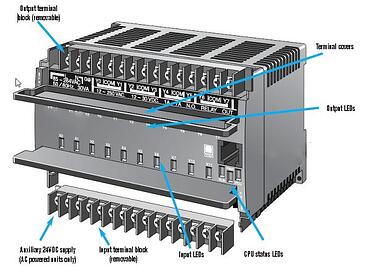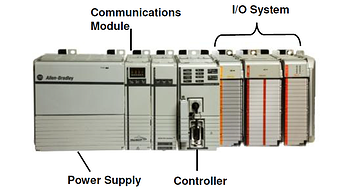
Programmable logic controllers, or PLCs, are industrial and/or commercial computers created to run automated systems. Whether you know it or not, you come into contact with PLCs on a regular basis. From roller coasters at a theme park to traffic lights on Main Street, PLCs are the unseen, crucial component to automated life as we know it. Originally developed to replace relay circuits, PLCs have taken on a life of their own, and working with them can be exciting and rewarding.
There are two main types of PLCs - modular and fixed. Most professionals in the industry say modular PLCs have many distinct and important advantages over fixed PLCs. This article will discuss the advantages and briefly explore the programming methods used for PLCs.
Basic Programming Information
If you are familiar with computer programming, you know the basic processes are the same. Each programmer has their own style and method to accomplish the job. Likewise, PLC programmers develop their own unique way of doing things. Regardless of personal style, the following five programming methods are the most commonly used.
Ladder Logic or Ladder Diagrams
The diagram for the wiring schematic of a relay circuit is representative of a ladder diagram. In a ladder diagram, the output is to the right and the "power line” is to the left. Because the input and output sections look so much like rungs on a ladder (---| |---( )---), this programming method is referred to as the ladder diagram. It is the most preferred programming method.
of a relay circuit is representative of a ladder diagram. In a ladder diagram, the output is to the right and the "power line” is to the left. Because the input and output sections look so much like rungs on a ladder (---| |---( )---), this programming method is referred to as the ladder diagram. It is the most preferred programming method.
Function Block Diagram
As the name implies, this programming method is a diagram wherein the various functions being programmed each has a box with a line linking the function to the output it produces.
Sequential Function Chart
A sequential function chart is a diagram that visually depicts the PLC process in a fashion that resembles a highly complex flow chart. Each sequential function chart has three main components: steps, actions, and transitions. Each step has an action associated with it; and, transitions are what help move the process from one step to the next.
Structured Text
Structured text, unlike the previous programming methods, is not a pictorial method or a chart. It is more of a programming language. For those with a computer programming background, this method is likely to be the easiest to understand. However, it is rarely used with PLCs.
Instruction List
An instruction list is the most complicated of all the programming methods. It is very much like an assembly language. While this method is good for many things - particularly processes that have small, repetitive actions or functions - it's often far easier to compile a ladder diagram than it is to learn how to use this programming method.
Modular and Fixed PLCs
As mentioned, PLCs have two main categories: modular or fixed. Both have the same basic functions. A PLC is much like a personal computer. It consists of a central processing unit (CPU) and an input/output (I/O) interface system. The difference between a PC and PLC is that PLCs handle multiple configurations and carry out control functions. All I/O systems consist of message or information carriers - inputs - and controllable devices - outputs. Any switches, sensors, or other similar devices are physically linked to the main I/O system and all of the activity throughout the entire system is controlled by the CPU.
This is the same regardless of whether you're using a modular or a fixed PLC. However, these two systems are very different in application and execution.
- Fixed PLCs are typically designed to perform basic functions. They are small and consist of a power supply and the CPU and I/O systems, which are all housed in one entity. The proper functioning of all processes largely depends on the flawless execution of every component.

- Modular PLCs, also known as rack-mounted units, consist of bases allowing for many independent components, such as the installation of numerous I/O modules. These are easier to repair.

Advantages of Modular PLCs
What are the main advantages of a modular PLC?
Memory
Fixed PLCs are only capable of housing so much information. This is because of the fact that all the necessary parts are housed in one entity. Also, there isn’t a lot of room for expanding information beyond the very basic functions it requires. Modular PLCs have far more memory and have the capability to store a higher volume of information.
Greater Number of Available I/O Modules
The fixed PLC has limited I/O modules thus limiting its performance. The modular PLC has the capacity to accomplish more complex processes making it more advantageous.
Room for Expansion
As the need to expand your operation arises, the fixed PLC will not be able to grow with the company. Modular PLCs were designed for that purpose, to expand and customize processes for seamless growth.

Easier to Troubleshoot, Less Downtime
Downtime costs money- no one wants a system that drains the profits. Fixed PLCs do not alert the operator of problems. Thus, when they crash it takes considerable time to troubleshoot the problem. However, the modular PLCs can easily troubleshoot issues, keeping some processes operational while fixing the issue. While fixed PLCs may be less expensive, initially, the modular PLC has greater economic security long-term.
Mix and Match
Another great feature of modular PLCs is the modules can be mixed and matched thanks to pluggable I/O sections. This offers greater customization capabilities; a more diverse experience; and more complex processes than a fixed PLC could ever offer.
Career opportunities expand when one understands PLCs Where ever the opportunity arises- theme parks, oil refineries, manufacturing, municipalities, etc., knowing about and understanding PLCs will give you the edge on the competition. Taking classes and becoming professionally trained in PLCs can help you obtain a lucrative and rewarding career. To learn more about the career-building PLC classes Continuing Education/ Workforce Training offers Click here.

.png?width=220&name=Do%20You%20Pocatello%20Podcast_%20(1).png)

